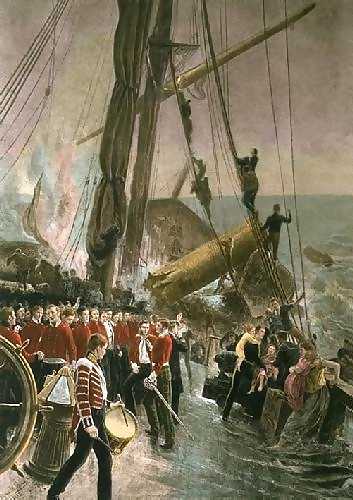
Discipline. Honor. Sacrifice - and steadfast leadership. Do you really know what they mean? How do you know you, as well as the men and women under your command, can do what is needed - and do it with cold firmness?
Are you ready for the Birkenhead Drill?
To take your chance in the thick of a rush, with firing all about,A little bit from Kiplings "Soldier an' Sailor too!" Here is the background.
Is nothing so bad when you’ve cover to ’and, an’ leave an’ likin’ to shout;
But to stand an’ be still to the Birken’ead drill is a damn tough bullet to chew,
An’ they done it, the Jollies—’Er Majesty’s Jollies—soldier an’ sailor too!
Their work was done when it ’adn’t begun; they was younger nor me an’ you;
Their choice it was plain between drownin’ in ’eaps an’ bein’ mopped by the screw,
So they stood an’ was still to the Birken’ead drill,2 soldier an’ sailor too!
At 2 a.m. the following morning, the Birkenhead struck an uncharted rock at 34°38′42″S 19°17′9″E / -34.645, 19.28583 near Danger Point (today near Gansbaai, Western Cape). The barely submerged rock is clearly visible in rough seas, however it is not immediately apparent in calmer conditions. The initial impact ripped open the forward watertight compartment between the engine room and the fore peak, immediately flooding it and drowning over 100 soldiers in their hammocks. A second impact ripped open the bilge in the engine room, resulting in the two largest watertight compartments in the vessel being been flooded.Ponder that for a bit.
The surviving officers and men assembled on deck, where Lieutenant-Colonel Seton of the 74th Regiment of Foot took charge of all military personnel and stressed the necessity of maintaining order and discipline to his officers.Almost everybody kept silent, indeed nothing was heard, but the kicking of the horses and the orders of Salmon, all given in a clear firm voice.Distress rockets were fired, but there was no assistance available. Sixty men were detailed to man the chain pumps, sixty more were assigned to the tackles of the lifeboats, while the rest were assembled on the poop deck, in order to raise the forward part of the ship.
Poor maintenance and paint on the winches resulted in only a few of the ship's lifeboats being launched, and the two large boats, with capacities of 150 men each, were not among them.
Eventually two cutters and a gig were launched, onto which all the women and children were placed and rowed away for safety. Only then did Captain Salmond order that those men who could swim should save themselves by swimming to the boats; Lt-Col Seton, however, recognizing that rushing the lifeboats would risk swamping them and endangering the women and children, ordered the men to stand fast.
The cavalry horses were freed and driven into the sea in the hope that they might be able to swim ashore. The soldiers did not move, even as the ship broke up barely twenty minutes after striking the rock.
FYI, that is where the phrase "women and children first" originated.
Hat tip CO-ED Combat









No comments:
Post a Comment